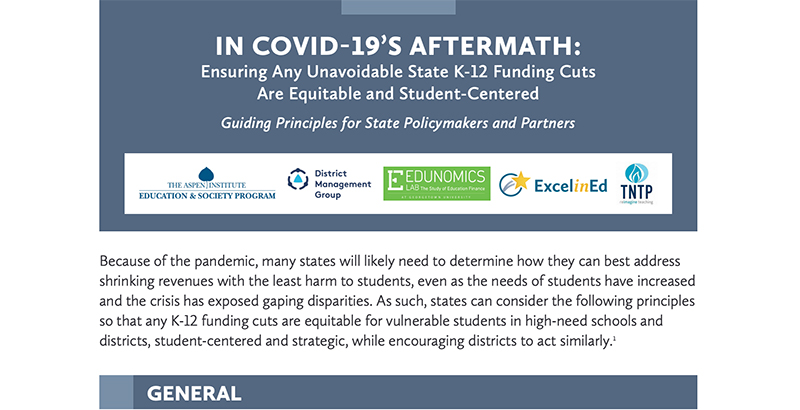Analysis: What’s the Least Terrible Way for States to Make COVID-Related K-12 Funding Cuts? New Guidelines Offer Some Principles to Follow

Unless states start preparing and planning for the possibility of budget cuts, students nationwide will face grave harm from the upcoming fiscal tsunami caused by the COVID-19 pandemic.
ExcelinEd recently joined a diverse group of organizations — the Aspen Institute, the District Management Group, the Edunomics Lab and TNTP — to publish essential principles we hope states will consider if they need to temporarily reduce K-12 funding. By adhering to these principles, states can make budget cuts that are equitable, student-centered and strategic, and encourage school districts to act similarly.
Of course, we hope state policymakers will protect K-12 funding to the fullest extent possible. That is the first of our principles. Education is one of the few priorities specifically mentioned in many state constitutions. K-12 cuts can slow down recovery and diminish a state’s economic vitality. However, states must prepare for the worst and make the best decisions should K-12 cuts be unavoidable.
Historically, states have not made the wisest decisions. When faced with severe revenue drops like during the Great Recession, for example, states made across-the-board cuts that particularly hurt vulnerable students.
Further, they often waited until the last minute, leaving districts with no alternative but to make abrupt and painful midyear cuts. Over the years, state funding reductions have eliminated important new K-12 programs, leaving untouched older programs without proven benefit to students. And decisionmakers have turned a blind eye when districts made deeply inequitable cuts.
The damage to students is magnified by these actions beyond that which must occur in tight fiscal times. Education funding levels were just beginning to recover from cuts made 10 years ago when the pandemic struck. States do not need to have their children face another decade of struggle.
Already, vulnerable students are suffering the most from COVID-19’s impacts, experiencing deeper learning loss and more trauma than their more advantaged peers. These students are often in districts that have the least resources and depend the most on state funding. States that want to address the needs of these students can take steps to ensure that they are not disproportionately harmed by any budget reductions.
If states are going to provide less funding in the coming year, they can help districts make the most of existing resources by giving them greater flexibility. Rather than having a multitude of separate funding programs, each of which has its own intricate rules and restrictions, states can create one core formula that is student-centered. This means each district, whether traditional or charter school, receives a base dollar amount for each student it serves, plus substantial additional funding for vulnerable students.
States can also mitigate the harm of funding cuts by prioritizing their most cost-effective programs, looking at actual impact on student learning, consistency with research and strategic importance. For example, many states have recently invested in early literacy initiatives, which should not be cut just because they are the newest.
Policymakers at the state and local levels are more likely to make thoughtful decisions when there is absolute transparency about how dollars are being spent by district leaders at the school level. Detailing where budget and staffing decreases are occurring in a district can help ensure high-need schools are escaping disproportionate cuts.
As districts pass down cuts in state funding to schools and students, states can play a critical role in encouraging districts to make budget cuts that are equitable, student-centered and strategic. They can provide cover for districts that want to make tough decisions now in order to avoid more harmful cuts in the future. They can allow districts to have the flexibility to reconfigure staffing for hybrid and distance learning and to cost-effectively address the exploding needs of students for academic tutoring and counseling.
State policymakers cannot afford to wait for a federal bailout to plan their education budgets. Our organizations certainly hope more federal funds will come. In the meantime, if states can adhere to these recommended principles, they can minimize harm to students and maximize the ability of districts to make best use of the available resources.
Matthew Joseph is the policy director for funding at ExcelinEd. Also contributing to this piece: Nathan Levenson, managing director at the District Management Group; Dan Weisberg, chief executive officer at TNTP; and Ross Wiener, vice president at the Aspen Institute.
Get stories like these delivered straight to your inbox. Sign up for The 74 Newsletter

;)
